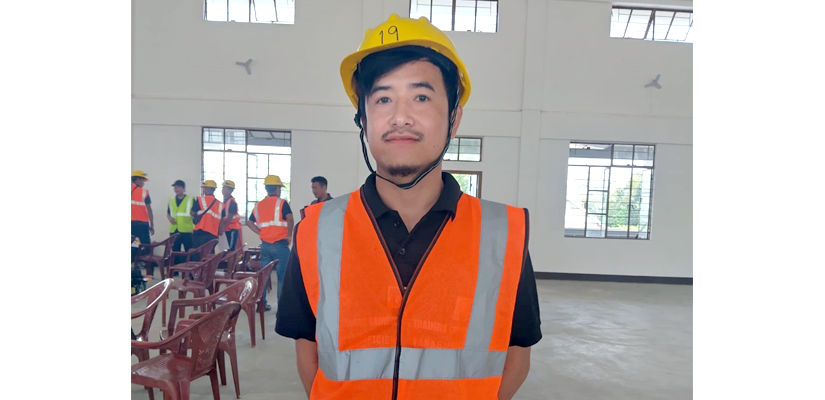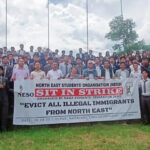Training concludes successfully in Chungtia and Süngratsü

“In Nagaland, there is no way an average house owner can identify who is a skilled ‘mistry’ and who is not,” stated Architect Richard Belho, Chairman of Zynorique Initiatives Society, highlighting a common problem faced by households in Nagaland that reflects the skill gap in the construction industry.
With this in mind, a training focused on skill assessment was conducted in Chungtia village, beginning on August 30, 2024. What started as a skill-training session turned into a transformational journey for 50 construction workers. The ‘Skill Proficiency Management Training for Building and Other Construction Workers,’ held at the Sericulture Resource Centre in Longtsüktep, Chungtia Village, aimed to do more than certify new trainers; it sought to address the unemployment and skills crisis in Nagaland and India as a whole. Could this program truly transform the community?

Among the trainees was 57-year-old mason Tinumeren, who has worked in construction for years. Taking the training course on masonry and reinforced cement concrete (RCC) construction, he noted one crucial lesson: “I’ve been working as a mason for a long time, but I learned during the training that my cement mixture ratio was too high. If we follow the mixture they provided us in training, we can save a lot and be more economical,” he shared. He also picked up skills in leveling and aligning bricks, calling it “a very good training” that taught him much.
The program was organized by Nagaland Building and Other Construction Workers’ Welfare Board (NBOCWWB) under the Department of Labor in collaboration with Zynorique Initiatives Society.
Project Manager Chetan Sharma from the training partner of Zynorique Initiatives Society expressed gratitude that all the 50 trainees were committed and took the training seriously and that they were able to pass in both the theory and in practical.
“I am confident that this training will be productive,” he said, explaining that the 372-hour program certified 21 electricians, 10 in plumbing and tiling, 2 in stone masonry, and 17 in bricklaying and RCC.

Tinuneken, 28, one of the top 5 performers among the trainees, chose to train in the electrician course because of his passion for the trade. Following the training, he feels more confident in his knowledge. “Before, I wasn’t aware of many things, but now I feel like I have at least learned the basics. I believe I am slightly more confident than I was before and I believe with dedication, there’s much more we can do,” he shared.
Appreciating the opportunity, Tinuneken noted that he had not been doing anything following his graduation. He added, “It’s nice to learn and gain knowledge about such work.”
The program’s completion has given hope not only to Chungtia Village but also to the greater Mokokchung area. “Whenever we need to build RCC buildings or machinery work, we usually bring workers from outside our village. But now, with the 50 of you, I hope you will use what you’ve learned to become self-reliant and share your skills with others,” said Chungtia Village Council Chairman N Bendang.

Sangpangchang Lonkumer, EAC of Ongpangkong, praised the project as “wonderful” and encouraged the newly certified workers to seize the opportunity to enter the local market, especially in Mokokchung, where much of the workforce currently consists of non-locals. “Now that you are certified, explore the market,” the EAC urged.
Nungsangtoshi Aier, District Regional Officer of NBOCWB, Department of Labor, highlighted the advantages of the Labor Card and encouraged the workers to register on November 13. The Labor Card is designed to bring unorganized workers into the formal system, providing identification and access to welfare schemes and benefits.
According to Aier, the Labor Card benefits include a tool grant of Rs 2000 every financial year, a medical scheme offering Rs 1000 per day for the first 5 days in hospital and Rs 500 per day for the next 10 days, as well as scholarships for children up to Class 10, providing Rs 6000 per child each year. Maternity benefits of Rs 6000 are available twice a year, along with an insurance policy that provides Rs 4 lakhs for accidental death and Rs 2 lakhs for natural death. Aier also noted that a pension scheme is planned, pending the Labor Card’s implementation for a 10-year duration.
The same training was also conducted in Sungratsü Village, where there were 50 candidates: 22 from electrical, 16 from plumbing and tiling, 10 from RCC, and 2 from stone masonry. Unlike Chungtia, it was informed that the candidates were skilled in their work but lacked knowledge of theory and the necessary tools and certification which made them attend the training.
“The NBOCWWB Department, in collaboration with the Zynorique Initiative Society, provided everything regarding tools, certificates, and training. Each individual felt overwhelmed with gratitude and had no regrets about their participation,” Chetan informed.



